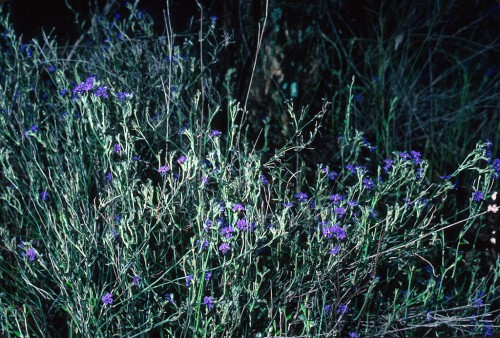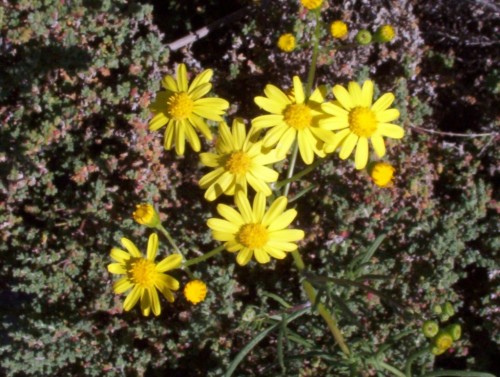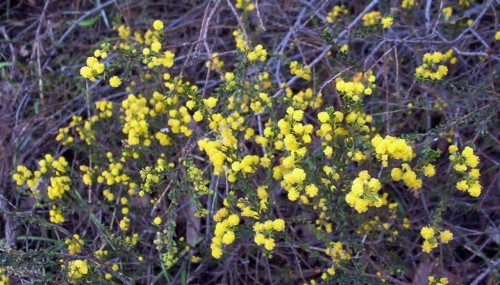Dampiera rosmarinifolia
Dampiera are suckering plants which form clumps, increasing from an underground root stock from which new growth arises. When this happens is a good time to prune out old growth and tidy the clump. This photo was taken in Little Desert National Park in Western Victoria and I suspect it is a subspecies of Dampiera rosmarinifolia. I will check that when I get access to my reference books again.
This is a hardy plant and has grown very well in our 350 mm of rain which we usually get in the winter. It flowers in the spring with these dark purple flowers. We have a pink and a mauve version of this also. It needs well drained soil which can be achieved by mounding the soil. Even as little as 10 cm will improve drainage.
Mallee Scrub
‘The Mallee’ is a term covering several scenarios. The Mallee is a term used to describe areas of the country which are covered in mainly Eucalypts of the mallee type. A feature, and this is what I love, is the variety of smaller plants forming the understory. These plants are often prolific and very colourful flowering plants.
We talk about Mallee towns being those towns, usually in farming communities, which exist because of the mallee areas being cleared for farming.
The photos show parts of Lowan Conservation Park including the access track through the park.
Senecio lautus (pinnatifolius) Variable Groundsel
This is a deep yellow daisy common around here. The seed germinates readily and the flowers create a delightful display. They are generally an annual but some can persist as a perennial if the season has been good. A good season like we had last year saw masses of the plants and a great floral display. Nowhere near the same number of plants this year but those that are there are beginning to flower.
We saw some of these plants along the board walk at St Kilda the other day. There is a form that grows here known as the ‘Mallee’ form subspecies dissectifolia. The one at St Kilda would be the coastal form.
They grow to a height of 40-60cm. They need full sun and good drainage. There is also a Forest form which grows in Victoria, New South Wales and Queensland. This form grows to 1m tall by about 80cm wide, with large leaves 4-15cm long. Tip pruning produces a bushier plant.
I think these would be great as a bedding plant in gardens. They flower for months.
Acacia rhetinocarpa
Acacia rhetinocarpa is a rare wattle which is endangered in South Australia. I have a plant given to me many years ago. Every year I miss out on the seed as the pods seem to split quickly and seed has gone before I get a chance to collect them. Seeing the abundance of the flowers this year hopefully means that seed will set and if I am organised I will try to put a stocking bag over a few branchlets to catch the seed.It is a pretty ornamental wattle.
Members of the local Australian Plant Society used to check on a small colony of plants near here. The plants grew in a position where they received some water run-off from the road. Ferries McDonald Conservation Park in South Australia has some colonies which were protected by the Field Naturalists Society.
My plant is only about a metre tall and wide. They can get to one and a half metres but mine is growing at the base of some mallee trees and has root competition.This is another tough drought, frost and lime tolerant plant.
Plants at Monarto Zoo
This morning we took we took my mother and niece to Monarto Zoo, about an hour east of Adelaide along the South Eastern Highway. We haven’t done the bus tour for ages. It was great although very cold today.
A highlight of the trip was seeing two brand new baby giraffe, born last Friday and Saturday. One was still wonky on its legs but got up to suckle for a while from its mother. The other was content to doze in the weak sun for a while. Giraffe are amazing creatures.
As are the African Painted Dogs. There has been a good season for them too. Heaps of 6-8 week old puppies scrambling and playing quite roughly with each other. It was quite a creche. Apparently the other adult dogs help to raise the pups and feed them. One adult was giving quite strong taps with its front paw to a pup.
There is such a lot to see at the Zoo. New developments are taking place as money becomes available. We enjoyed a concert there last year, with the Adelaide Symphony Orchestra. This was a fund raiser for the Zoo.
On one of the walks today there was an abundance of Lomandra effusa, Scented Mat Rush. In fact the vegetation was looking in good heart. This Lomandra was in quite dense communities. It will be good to do the walks at the end of the winter as this is an area where the wild flowers are lovely then. Prostanthera eurybioides (Monarto Mint Bush) was in flower in the Zoo plantings.




